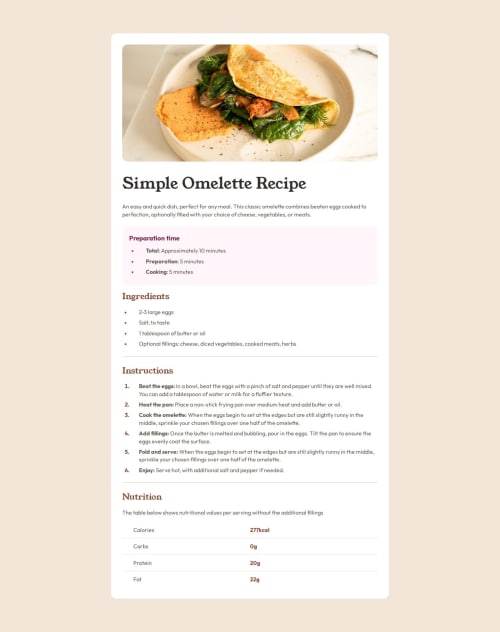Used HTML5, CSS3(Grid), Google Font, vars, and ARIA for accessibility.

Solution retrospective
-
HTML5:
- Implemented semantic elements like
<main>and<section>, and to enhance document structure. - Applied ARIA labels to provide better context for assistive technologies (e.g.,
aria-label="Instructions"). - Used descriptive alt attributes for images to support screen readers and improve accessibility.
- Implemented semantic elements like
-
CSS3:
- Utilized CSS Grid and Flexbox to create a responsive and well-structured layout.
- Applied CSS variables
:rootfor better maintainability of colors and consistent theming. - Styled list markers with
::markerto differentiate list items visually. - Used media queries to ensure the layout adapts correctly on smaller devices.
-
Accessibility Enhancements:
- Ensured accessible navigation by adding ARIA labels to key content sections like ingredients, instructions, and nutritional information.
- Adjusted color contrast between text and background based on WCAG guidelines.
<ul>and<ol>tags are used for the ingredients and instructions, ensuring that screen readers can properly interpret the sequence of items.- The use of
<section>elements to group related content (e.g., recipe image, preparation time, ingredients, instructions, and nutritional information) improves document structure, making it easier for users with disabilities to navigate the page.
-
Responsive Design:
- Adopted a mobile-first approach, ensuring compatibility with various screen sizes.
- Applied
max-width: 800pxto prevent content from becoming too wide on larger displays. - Utilized
place-content: center with CSS Grid to center the content both vertically and horizontally.
Please log in to post a comment
Log in with GitHubCommunity feedback
- @codeBloom361
Good job completing this challenge. Your solution looks good and the code is clean.
Join our Discord community
Join thousands of Frontend Mentor community members taking the challenges, sharing resources, helping each other, and chatting about all things front-end!
Join our Discord